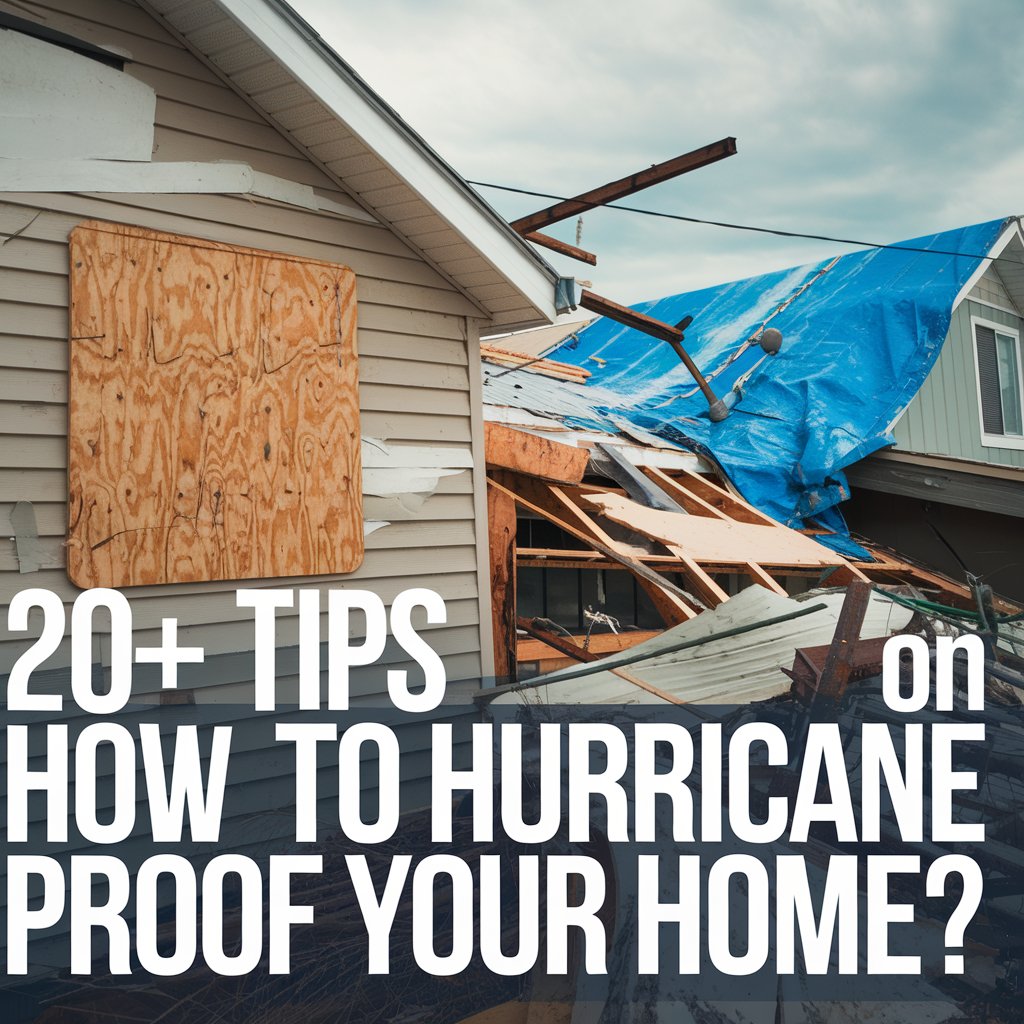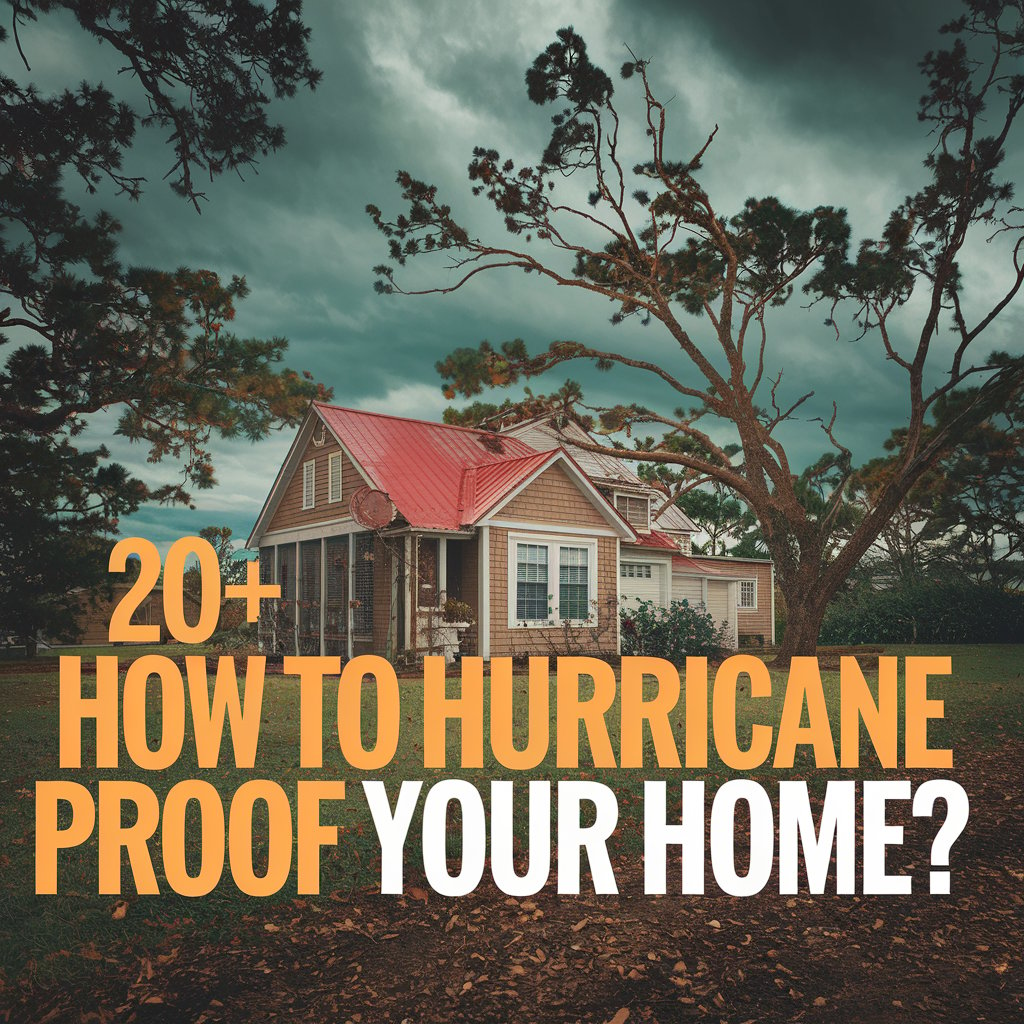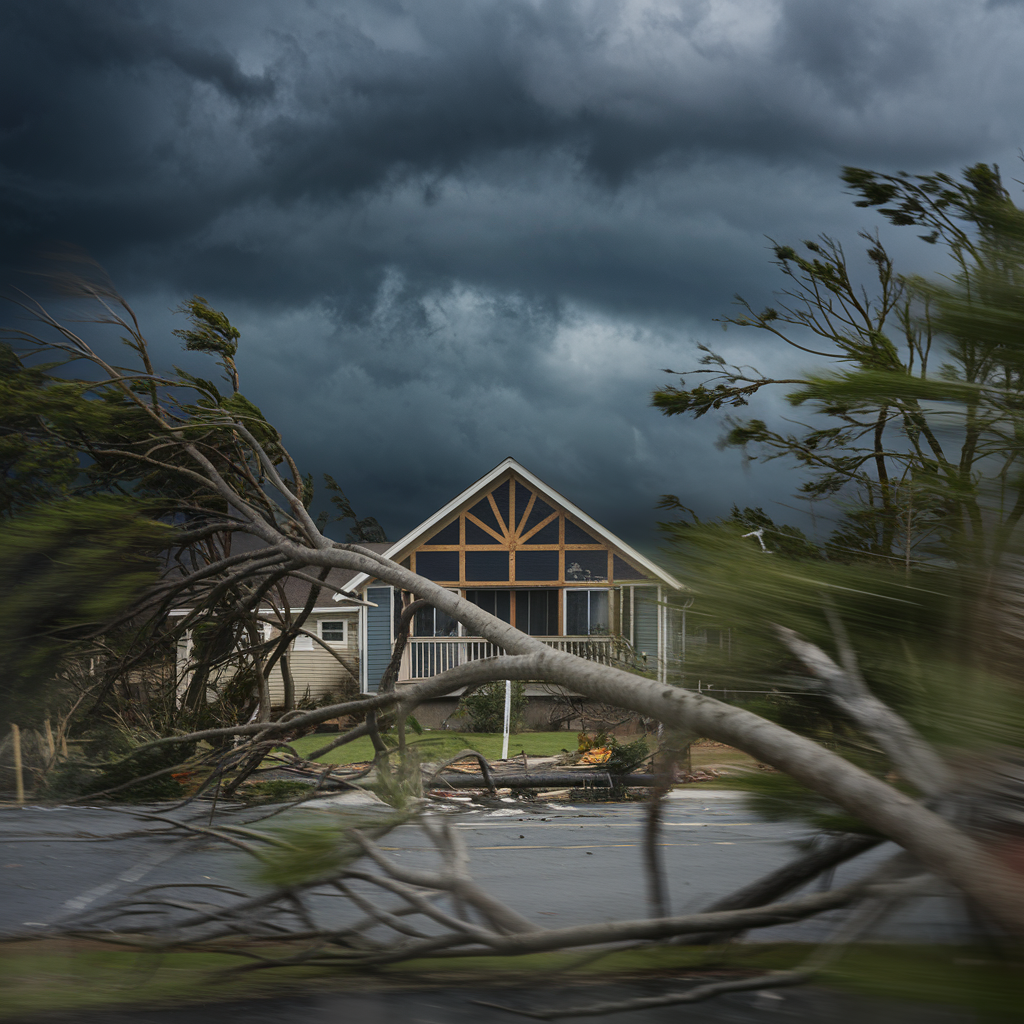20+ Ingenious Tips to Hurricane Proof Your House
Hurricanes have always posed a significant threat to homeowners in coastal areas, but with the impact of climate change, these storms are becoming more frequent and more intense. Once rare occurrences, storms like Hurricane Harvey of 2017 are now happening every 16 years, compared to every century before the 1970s. The combination of high winds, torrential rain, and storm surges can devastate homes and lives.
As a homeowner, your best defense against hurricanes is preparation. By evaluating the weak points in your home and making the necessary improvements, you can protect your property and the lives of those inside. This comprehensive guide provides 30+ essential strategies for hurricane-proofing your home, ensuring that you’re well-prepared for the next storm.

Why is it Important to Prepare Your House for a Hurricane?
Investing time in hurricane-proofing your home can make the difference between an inconvenience and a disaster. Thanks to advancements in technology, many damaging effects of hurricanes can now be mitigated. Benefits of preparing include:
- Improved safety: Your belongings can be replaced, but your loved ones cannot.
- Reduced repair costs: Prevention is much cheaper than repairs.
- Less stress: Minimize anxiety before the storm and avoid post-hurricane recovery stress.
- Protection of valuable belongings: Some items are irreplaceable.
Hurricane-proof house design incorporates materials and structures that withstand the high winds and rains associated with hurricanes. These designs include reinforced roofing, impact-resistant windows, and elevated foundations to prevent flood damage. Sustainable elements like solar panels and rainwater harvesting systems are becoming popular, contributing to both resilience and a reduced environmental footprint.

Weather-Resistant vs. Weatherproof
Understanding the difference between weather-resistant and weatherproof materials is key to making informed decisions when building or renovating a home in hurricane-prone areas.
- Weather-Resistance: Refers to materials that can withstand typical weather conditions but may eventually degrade with prolonged exposure. These materials repel water and resist sun damage to some extent but aren’t entirely immune to the elements.
- Weatherproof: Suggests a higher level of protection. Weatherproof materials and structures are built to endure extreme conditions like heavy rain, wind, and sun without deterioration, offering a permanent barrier against weather-related damage.
How Much Does it Cost to Hurricane Proof Your Home?
Hurricane-proofing costs can add up, often reaching over $30,000. The investment, however, is worthwhile when compared to the potential cost of damage. Homeowner financing options such as borrowing against home equity or PACE financing can help cover these expenses.
Prepare Your Florida Home for Hurricanes
Preparing your home for a hurricane requires both money and planning. With Home Run Financing, you can secure the funds needed for windows, doors, roofing, or structural reinforcements. Contact Home Run Financing to learn more about PACE financing in Florida or apply today to get your home renovation project started.
15 Hurricane-Proof House Design Ideas
- Fully Sealed Roofs: Utilize materials like EPDM (rubber roofing) for durable, impermeable roof coverings that resist UV rays and heavy rainfall.
- Waterproof Exterior Coatings: Apply liquid rubber or elastomeric paint to exterior walls for a waterproof seal that prevents leaks.
- Submersible Basement Construction: Use water-resistant concrete and membranes to create basements that can withstand groundwater pressure.
- Integrated Drainage Systems: Install French drains, graded landscaping, and sump pumps to manage excess water.
- Hurricane-Proof Windows: Impact-resistant windows with laminated glass and sturdy frames protect against wind and debris.
- Flood Shields for Doors: Removable barriers, like aluminum or steel panels, prevent water ingress during floods.
- Sealed Ductwork: Fully sealed duct systems prevent moisture infiltration, enhancing energy efficiency and air quality.
- Elevated Electrical Systems: Install electrical components above flood levels to prevent outages and reduce fire risks.
- Marine-Grade Materials: Use marine-grade stainless steel, plywood, or fiberglass for fixtures that withstand salty air and moisture.
- Watertight Skylights: Double-sealed, impact-resistant glass skylights prevent leaks and withstand debris.
- Indoor Water Collection Points: Design water-safe areas with drains and waterproof flooring to manage accidental water ingress.
- Underwater Ground Anchors: Stabilize foundations against erosion with deep-driven anchors.
- Flood-Resistant Flooring: Choose ceramic tiles, sealed concrete, or vinyl flooring that resists moisture.
- High Water Alarms: Install alarms in flood-prone areas like basements to alert homeowners to water presence.
- Backwater Valve Installation: Place valves in sewer lines to prevent sewage backup during heavy rains.

Start With a Home Vulnerability Assessment
Before you begin hurricane-proofing your home, it’s essential to conduct a thorough vulnerability assessment. Identify the weak points in your home, including windows, doors, the roof, and even your landscaping. Knowing which areas need improvement will allow you to prioritize upgrades and allocate resources effectively.
- Pro Tip: Hire a professional inspector to assess the structural integrity of your home. They can point out areas you may have missed, ensuring a more comprehensive approach.
Protecting Windows: Your First Line of Defense
Windows are among the most vulnerable parts of a home during a hurricane. If they break, water and wind can infiltrate your home, causing extensive damage. Here are several ways to protect your windows.
Install Impact-Resistant Windows
Impact-resistant windows are designed to withstand high winds and debris. These windows feature heavy frames and a laminated surface that prevents the glass from shattering. Some models even have two panes with a shatter-proof membrane in between, providing an additional layer of protection.
- Pro Tip: Impact-resistant windows not only offer hurricane protection but also improve energy efficiency by providing better insulation.
Upgrade Your Skylights
If your home has skylights, don’t overlook them during storm preparation. Skylights are more fragile than regular windows and can be vulnerable to breakage during a hurricane. Consider replacing them with more durable glass or a tubular daylighting device, which reduces the glass surface area while still allowing light into your home.
Use Hurricane Film
While hurricane film won’t protect your windows from wind, it can prevent the glass from shattering. Hurricane film also blocks harmful UV rays, adding an extra layer of protection for your home’s interior.
Install Temporary Hurricane Shutters
Temporary hurricane shutters can be installed when a storm is approaching. These are removable panels placed in tracks installed around windows. They protect the glass from flying debris and prevent high winds from entering the home.
Install Permanent Hurricane Shutters
Permanent hurricane shutters are a more long-term solution. These shutters roll down like a garage door or swing open and closed depending on the design. They provide consistent protection and can even help reduce heat gain during sunny days.
Fortify Your Doors Against Hurricane Winds
Your home’s doors are another point of vulnerability during a hurricane. If they fail, high winds can enter your home and cause significant damage.
Upgrade to Hurricane-Proof Doors
Hurricane-proof doors are designed to withstand impacts from flying debris and high winds. They are often made of aluminum or fiberglass, which are much more durable than wood doors.
- Pro Tip: Ensure that your doors have heavy-duty deadbolts to keep them closed during extreme winds.
Strengthen Garage Doors
Garage doors are particularly susceptible to wind damage, and failure here can allow wind to enter and lift the roof off your home. Most hurricane damage starts when wind penetrates the home through the garage.
Install Hurricane-Rated Garage Doors
Consider upgrading your garage doors to ones specifically designed to withstand hurricane-force winds. These doors are reinforced and can hold up under pressure.
Retrofit Existing Garage Doors
If you’re not ready to replace your garage door, a vertical bracing system can be installed to strengthen it. These supports help prevent the door from buckling under intense winds.
Reinforce Your Roof for Maximum Protection
The roof is often the first part of a home to sustain damage during a hurricane. It’s crucial to reinforce your roof to ensure it can withstand the high winds and rain that accompany strong storms.
Use Hurricane Clips or Straps
Traditional roofs are often connected to homes using “toenails,” which are nails driven in at an angle. While these are sufficient in normal weather, they may fail during a hurricane. Hurricane clips, also known as hurricane straps, provide a stronger connection between the roof and the house’s rafters and trusses.
- Pro Tip: Hurricane clips are often made of steel and can significantly reduce the likelihood of your roof lifting off during a storm.
Install a Secondary Water Barrier
If your roof is damaged, a secondary water barrier can help prevent water from seeping into your home. This layer is installed beneath the outer roofing materials (like shingles) and provides extra protection against leaks.
Replace an Aging Roof
If your roof is old or damaged, consider replacing it entirely. A new roof can not only improve your home’s hurricane resistance but also enhance energy efficiency and insulation.
Inspect and Maintain Your Roof Regularly
After each hurricane season, inspect your roof for damage, loose shingles, or other vulnerabilities. This can help prevent small issues from turning into major problems during the next storm.
- Pro Tip: While you’re inspecting your roof, check your gutters and downspouts to ensure they are clear of debris. Properly functioning gutters help direct rainwater away from your home.
Secure Your Home’s Exterior: Siding, Soffits, and Fascia
Reinforce Siding
If your home’s siding is weak or old, it may become detached in high winds. Reinforcing your siding or upgrading to more durable materials can help reduce damage.
Strengthen Soffits and Fascia
Soffits and fascia are also vulnerable during storms. Ensure that these are securely fastened to the home’s structure, as any gaps can allow wind to enter and cause damage.
Landscaping Tips for Hurricane Preparation
Proper landscaping can protect your home by minimizing flying debris and potential hazards. Here are some tips to consider.
Trim Trees and Shrubs
Trees and large shrubs can become dangerous projectiles during a hurricane. Regular trimming makes them more wind-resistant and less likely to fall or break during a storm.
Remove Hazardous Trees
If a tree is diseased or too close to your home, consider removing it. A tree falling on your home during a storm can cause catastrophic damage.
Secure Outdoor Furniture
Patio furniture can easily become airborne during a hurricane. To prevent it from damaging your home, tie it down or bring it indoors when a storm is approaching.
Use Sandbags for Flood Protection
While sandbags aren’t a permanent solution, they can help direct water away from your home during a storm surge.
Essential Hurricane Supplies
No matter how well you prepare your home, having the right supplies on hand is crucial. These supplies can help you ride out the storm and address immediate damage afterward.
Assemble an Emergency Kit
Your emergency kit should include at least three days’ worth of water, non-perishable food, batteries, flashlights, a first-aid kit, and essential medications. Ensure that the kit is easily accessible and in a secure location.
Prepare for Power Outages
Hurricanes can knock out power for days or even weeks. Consider investing in a generator to keep essential systems running.
- Pro Tip: Solar-powered chargers and battery backups for your phone and other devices can also be lifesavers during long outages.
Keep Important Documents Safe
Flooding is a common concern during hurricanes, so it’s essential to protect important documents. Store passports, deeds, and insurance paperwork in a waterproof container and move them to the highest level of your home.
Hurricane Preparedness Tips from Government Resources
Government agencies like READY.gov offer additional advice for hurricane preparedness. These suggestions can help you stay safe and minimize damage to your property.
Know Your Evacuation Route
Make sure you’re familiar with the evacuation routes in your area. Your city or state should provide maps and instructions to ensure a safe exit if needed.
Stay Informed with Local Alerts
Subscribe to local weather alerts so that you’re always aware of storm developments. Knowledge is your first defense against an incoming hurricane.
Avoid Floodwaters and Downed Powerlines
The aftermath of a hurricane can be just as dangerous as the storm itself. Avoid walking or driving through floodwaters and stay clear of downed powerlines.
The Importance of PACE Financing for Home Improvements
Protecting your home from hurricanes can be costly, but financial assistance is available. Programs like Ygrene’s PACE (Property Assessed Clean Energy) financing allow homeowners to finance improvements, including hurricane-resistant upgrades.
The Importance of PACE Financing for Home Improvements (continued)
How PACE Financing Works
PACE financing allows homeowners to borrow money for energy-efficient and hurricane-resistant upgrades, with repayment through property taxes. This method makes it easier for homeowners to afford significant improvements without upfront costs.
- Pro Tip: Research local PACE programs to determine eligibility and understand the specific upgrades covered, such as impact windows and reinforced roofs.
Benefits of PACE Financing
- No Upfront Costs: Homeowners can make necessary improvements without paying out of pocket.
- Long Repayment Terms: Typically, PACE loans have longer repayment periods, making monthly payments manageable.
- Increased Property Value: Improvements made with PACE financing can increase your home’s market value, making it a wise investment.
Insurance Considerations for Hurricane Preparedness
Insurance is a critical component of hurricane preparedness. Understanding your policy and ensuring you have the right coverage can save you significant financial stress after a storm.
Review Your Homeowners Insurance
Ensure your homeowners insurance policy includes coverage for wind and flood damage. Many standard policies do not cover flood damage, so consider purchasing additional flood insurance through the National Flood Insurance Program (NFIP).
Document Your Property’s Condition
Before a hurricane hits, document your property’s current condition with photos or videos. This documentation will be invaluable when filing claims after a storm.
Understand Your Deductibles
Familiarize yourself with the deductibles in your insurance policy, particularly for hurricane-related claims. Higher deductibles may mean lower premiums, but they can also result in significant out-of-pocket expenses after a storm.
Creating a Hurricane Action Plan
A well-thought-out action plan is essential for ensuring safety during a hurricane. Include your family members in the planning process to ensure everyone knows their role and responsibilities.
Establish Communication Protocols
Designate a family member as the main point of contact. This person will help keep everyone informed, especially if family members are in different locations during the storm.
Create a Timeline for Preparations
Draft a timeline that outlines when you will begin securing your home and gathering supplies. Having a clear timeline helps reduce stress and ensures nothing is forgotten.
Plan for Pets
If you have pets, ensure you have supplies for them, including food, water, and medication. Identify pet-friendly shelters or hotels in case you need to evacuate.
The Role of Technology in Hurricane Preparedness
Advancements in technology have provided homeowners with tools and resources to enhance their hurricane preparedness efforts.
Use Weather Apps and Alerts
Download reliable weather apps that provide real-time updates about storms in your area. Set up alerts for severe weather to stay informed about changes in conditions.
Monitor Social Media for Local Updates
Follow local emergency services and weather channels on social media for the latest updates and emergency alerts. Social media can provide real-time information that is crucial during a storm.
Invest in Smart Home Technology
Consider smart home technology, such as weather stations, smart locks, and cameras. These can help monitor conditions and secure your home before and during a storm.
Post-Hurricane Recovery Tips
After the storm has passed, it’s essential to assess your property and address any damage promptly.
Safety First: Inspect for Hazards
Before entering your home, check for potential hazards, such as downed power lines, gas leaks, or flooding. If you suspect any dangers, contact local authorities for assistance.
Document Damage for Insurance Claims
Take photos and videos of any damage before making repairs. This documentation will help when filing insurance claims and provide proof of the damages incurred.
Work with Professionals for Major Repairs
For significant repairs, such as roof replacement or structural work, hire licensed professionals. They have the experience and expertise needed to ensure repairs are done correctly.
Community Involvement and Preparedness
Hurricane preparedness is not just an individual effort; it’s essential to engage with your community to foster a culture of preparedness.
Participate in Local Preparedness Programs
Join local community programs focused on hurricane preparedness. These initiatives often provide valuable resources and education on improving safety in your area.
Share Information with Neighbors
Share your knowledge and resources with neighbors to ensure everyone in your community is prepared. This can foster a sense of community and enhance overall resilience.
Attend Local Emergency Meetings
Many communities hold meetings to discuss disaster preparedness plans. Attending these meetings can help you stay informed about local resources and evacuation plans.
Final Thoughts: Stay Prepared Year-Round
Hurricane preparedness is an ongoing process. Taking proactive measures, conducting regular assessments, and maintaining your home will increase your resilience against future storms.
Stay Informed About Climate Change
As climate change continues to impact weather patterns, staying informed about its effects on hurricanes and other severe weather is essential. Understanding these changes can help you adapt your preparedness strategies over time.
Regularly Update Your Preparedness Plans
Review and update your preparedness plans annually to account for changes in your family, home, and community. Staying proactive ensures that you’re always ready for whatever nature throws your way.
Be a Resource for Others
As you become more knowledgeable about hurricane preparedness, consider sharing your insights with friends, family, and your community. Empowering others with knowledge can save lives and protect property.
Mold Prevention After a Hurricane
The threat to your home doesn’t end when the storm does. Mold can set in if moisture isn’t controlled. After a flood, thoroughly dry out all areas, repair water damage, and increase ventilation. Wear protective gear when cleaning mold and use fans or open windows to improve airflow.
Conclusion: Your Path to Hurricane Resilience
In conclusion, hurricane-proofing your home involves a comprehensive approach that encompasses structural improvements, emergency planning, insurance coverage, and community involvement. With the right strategies in place, you can protect your home, your family, and your peace of mind. Start today by taking small steps toward hurricane preparedness, and remember that every effort counts in the face of nature’s fury.
By following these guidelines and tips, you’ll be well-equipped to face any hurricane that comes your way. Stay safe and prepared, and remember that knowledge is your best defense against the storms ahead.







Post Comment